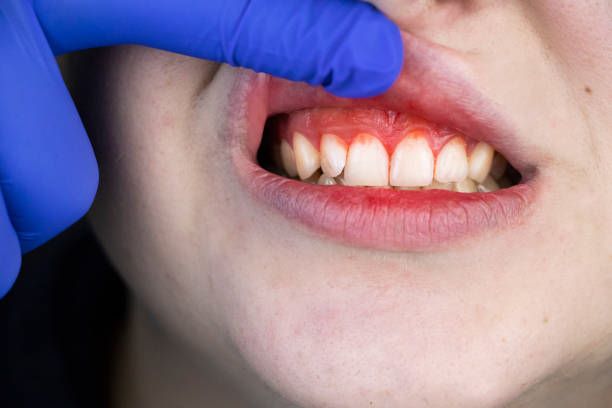Last Updated on: 5th December 2024, 09:46 am
One of the most common oral diseases described by the World Health Organization (WHO) and the American Dental Association (ADA) is gum disease, affecting as many as 10% of the world’s population in its most severe form. Many adults in the United States suffer from it, as confirmed by the National Institute of Dental and Craniofacial Research, considering that the stages of periodontal disease can range from simple inflammation of the gums to a serious disease that can damage the soft tissues and bones that support the teeth and lead to tooth loss as it progresses.
What is Periodontal Disease?
Gum disease, also known as periodontal disease or periodontal disease, is described by the WHO as an infectious disease of the tissues that surround and support the teeth.

This disease produces an inflammation that is mostly caused by bacterial growth in the mouth around the teeth and along the gum line. Gum disease will present itself in different ways depending on the severity or stage of the disease, and there will be four general stages. Gingivitis is the most common presentation, reversible, and causes more minor damage. Still, if it is not treated properly, it can become a more serious disease called periodontitis, this last stage being irreversible and with more severe damage such as the loss of teeth.
What are Gingivitis and Periodontitis?

Gingivitis as described is one of the stages of periodontal disease. It is caused by the accumulation of bacterial plaque on the teeth. If this bacterial plaque is not removed properly, it can accumulate at the gum line and cause inflammation of the gums. The term “periodontitis” is used to refer to the most advanced and severe stages of gum disease.
Causes of Gum Disease
Some of the main causes that will lead to gum disease are the following:
- Inadequate Oral Health Care: It is very common to find gingivitis in children and adults. This occurs when there is an accumulation of bacterial plaque on the teeth produced by inconsistent or incorrect oral care habits. That is why it is important to maintain good daily oral hygiene: brushing twice a day, flossing once a day, and rinsing twice a day with an effective antiseptic mouthwash approved by the American Dental Association.
- Position of teeth: Poorly positioned, crowded, or crooked teeth will promote plaque buildup since it is more difficult to clean them properly.
- Tobacco use: Cigarette smoking alters the normal function of gum tissue cells and makes the mouth much more vulnerable to infections, decreasing the ability of the gums to regenerate. Tobacco use in its various forms is going to increase the risk of developing gum disease greatly.
- Age: Older adults may be at greater risk for oral health problems because of a state of physical or mental decline, medication use, or lack of an oral care routine.
- General Health Problems: During periods of increased or changing hormones, the gums become more susceptible to contracting gum disease. During pregnancy, or even in a typical menstrual cycle, you may notice increased sensitivity of your gums. There are also other factors that can cause gum diseases, such as stress or genetic history.
8 Signs in the Early Stages of Periodontal Disease
1. Red and swollen gums

Gums that are healthy are firm and pink in color. If your gums change color and become red, swollen, or bleed when you brush your teeth, you most likely have gingivitis. All of these signs indicate that proper oral care is needed.
2. Bleeding gums

While it seems commonplace, it’s never natural for gums to bleed during brushing or flossing. You may think you’re brushing too hard, but frequent bleeding gums is a likely sign that you have gingivitis. Plaque and tartar remain on your teeth, so your gums become more irritated, and that causes them to swell, redden and become inflamed. Because of these situations, gums bleed easily, especially when you brush or floss. According to the ADA, bleeding gums caused by gingivitis are completely reversible.
3. Bad Breath (Halitosis)

there are indications that bad breath may also indicate an early stage of gum disease. Bad breath generally results from plaque buildup on the tongue and can be a sign that plaque and bacteria are not being properly removed.
4. Pain and sensitivity

Pain when chewing, sensitivity to hot and cold, receding gums, and loose teeth are signs of advancing gum disease, which is known as moderate or advanced periodontitis.
Signs to identify gum disease
From the American Dental Association, there are some warning signs that may indicate an abnormality in our gums, such as:– Gums that bleed easily– Red, swollen and sore gums– Gums that have pulled away from the teeth– Persistent bad breath or bad taste in the mouth– Loose or separating permanent teeth– Any change in the way the teeth fit together when you bite down– Any change in the fit of partial dentures
Contact Us:
If you have any questions about this topic or any other, feel free to contact or visit us at Channel Island Family Dental.At Channel Island Family Dental, we will be attentive to your visit to make a timely diagnosis. In addition, our dentists in Santa Paula, Newburry Park, Oxnard and Port Hueneme will be able to guide you to the best treatment to bring back your best smile.



